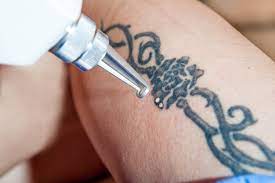Laser tattoo removal is generally safe when performed by a qualified professional, but there are several precautions you should take to ensure the best outcomes and minimize risks. For more detail visit our site (ازالة الوشم بسعر في الرياض) Here are key precautions to consider before, during, and after the procedure:

Before the Procedure
- Consult with a Qualified Professional:
- Expert Assessment: Ensure the practitioner is experienced and certified in laser tattoo removal. They should assess your tattoo and skin type and provide a realistic treatment plan.
- Medical History: Disclose any medical conditions, medications, allergies, and previous skin treatments to your practitioner.
- Avoid Sun Exposure:
- Protect the Area: Avoid sun exposure and tanning beds for at least 4 weeks before each session to reduce the risk of pigmentation changes and burns.
- Avoid Certain Medications and Products:
- Blood Thinners: Avoid aspirin, ibuprofen, and other blood-thinning medications a few days before the procedure, unless otherwise directed by your doctor.
- Skin Products: Stop using retinoids, glycolic acid, and other skin sensitizing products at least a week before treatment.
- Stay Hydrated:
- Hydrate Your Skin: Drink plenty of water to keep your skin hydrated, which can improve healing and treatment outcomes.
During the Procedure
- Pain Management:
- Numbing Cream: Apply a topical numbing cream 30-60 minutes before the session, as recommended by your practitioner.
- Cooling Device: Use a cooling device or ice packs during the procedure to minimize discomfort and swelling.
- Eye Protection:
- Safety Goggles: Always wear protective goggles provided by the practitioner to protect your eyes from laser exposure.
After the Procedure
- Immediate Post-Treatment Care:
- Cooling: Apply a cold compress to the treated area to reduce swelling and discomfort.
- Antibiotic Ointment: Apply a thin layer of antibiotic ointment to prevent infection and aid healing.
- Covering: Keep the area covered with a sterile bandage or dressing for the first 24 hours.
- Hygiene and Skin Care:
- Gentle Cleaning: Gently clean the area with mild soap and water, patting dry with a clean towel.
- Moisturizing: Keep the area moisturized with a fragrance-free, gentle moisturizer.
- Avoid Picking: Do not pick or scratch the treated area, even if it scabs or blisters, to prevent scarring.
- Avoid Sun Exposure:
- Sun Protection: Use a high SPF sunscreen and cover the treated area with clothing when outdoors to prevent pigmentation changes and burns.
- Avoid Water Immersion:
- No Swimming or Hot Tubs: Avoid swimming pools, hot tubs, and long baths until the area is fully healed to prevent infection.
- Avoid Strenuous Activities:
- Limit Physical Activity: Avoid activities that cause excessive sweating or friction on the treated area for a few days.
- Monitor for Complications:
- Signs of Infection: Look out for signs of infection such as increased redness, swelling, pus, or fever. Contact your practitioner immediately if you notice any of these symptoms.
- Follow-Up: Attend all follow-up appointments to monitor healing and adjust the treatment plan as needed.
Long-Term Precautions
- Skin Care:
- Continued Moisturizing: Continue to keep the skin moisturized to aid long-term healing.
- Ongoing Sun Protection: Protect the treated area from sun exposure indefinitely to maintain skin health and appearance.
- Healthy Lifestyle:
- Nutrition and Hydration: Maintain a healthy diet and stay hydrated to support your body’s natural healing processes.
- Avoid Smoking: Smoking can impair healing, so it is advisable to avoid it.
Conclusion
Following these precautions before, during, and after laser tattoo removal can significantly enhance the safety and effectiveness of the procedure, reduce the risk of complications, and ensure the best possible outcome. Always adhere to the advice and instructions provided by your qualified practitioner, and do not hesitate to reach out to them if you have any concerns during the treatment process.
